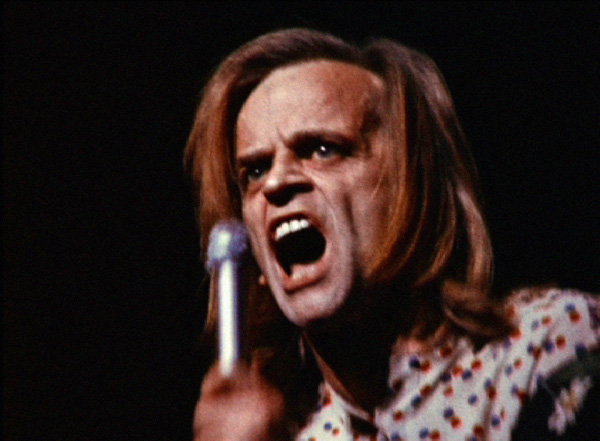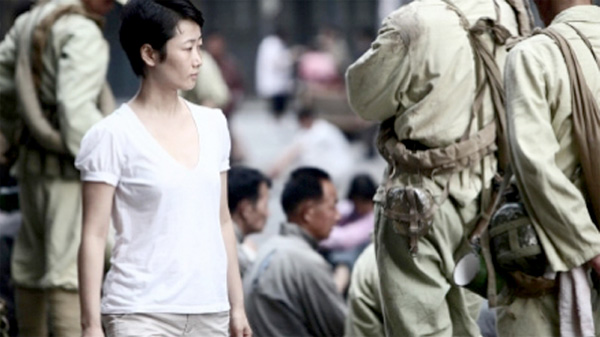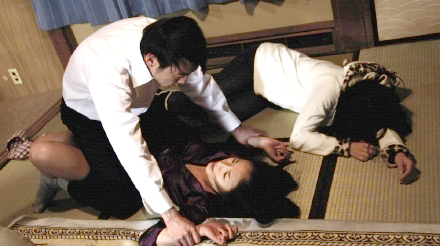|
Reviews of Recent Independent, Foreign, & Documentary Films in Theaters and DVD/Home Video

2011 Film
Comment Selects For the second time in a row, this annual mini-festival spotlights a French filmmaker, this year Isild Le Besco, an actress best known for collaborations with Benoît Jacquot. Her divisive and transgressive Bas-Fonds, funded with subsidies from France’s National Center of Cinematography, kicks off the 11th edition. Had this film been made in America with any taxpayer money, that funding program would be immediately squashed. The strong content in that and at least one other film (Cold Fish) may catapult some viewers toward the exit mid-screening, besides the raving Klaus Kinski’s solo turn as Jesus Christ, no less, in a 1970s time capsule. However, the programmers, the editors of the magazine Film Comment, have cast a wide net. These and the other selections mentioned below so far lack American distribution. Besides subject matter, many are just too hard to market for a number of reasons, which gives a strong impetus for one of the program’s objectives. Blink and the opportunity to see many of these films will be gone. Award-winning director Jia Zhang-ke’s new work, I Wish I Knew, has been treading the festival circuit since May with no theatrical prospects yet, and two documentaries by the great investigative filmmaker Claude Lanzmann are roughly an hour each, not long enough for a release on their own, but they would likely make for rewarding extras on a DVD rerelease of his monumental Shoah. Screening only once, the timely and insightful Sodankylä Forever is an ideal choice for audiences of the Film Society of Lincoln Center, which has championed the international directors in this talking-head extravaganza, a celebration of “problem-based intellectual cinema,” as director Jerzy Skolimowski calls it. But the gab is far from heady, rather it’s a lively and casual scattershot conversation—with World War II as a starting point. Located 75 miles from the Arctic Circle, Sodankylä, the Finnish small-town setting for the Midnight Sun Film Festival, was burned to the ground during the war. Since 1986, the festival has taken place every June, when the sun never sets. Its very first guest that year, Samuel Fuller, has a street named after him, to the wonderment of the late Egyptian director Youssef Chahine. In his country, streets are named “for generals, who have killed as many people as possible, or a politician, who has killed even more people.” There’s discussion of Iron Curtain repression and censorship (and most perniciously, to István Szabó, of self-censorship), and though the Berlin Wall may have fallen 22 years ago, a lot of what they have to say continues to reverberate. Last December, Iranian filmmaker Jafar Panahi, who is quoted in the film, was sentenced to six years imprisonment and a 20-year ban from filmmaking for opposing and protesting against his country’s regime. Thanks to the film’s substantive dialogue, polished production values won’t be needed or missed. If you ever need justification for spending hours and hours watching movies, this film gives you plenty. This year, one rarely seen film doubles as a posthumous tribute to Peter Yates, a director of many genres who passed away in January. Yates made Robbery (1967) a year before he shot Bullitt. It’s a no-brainer why Steve McQueen wanted him as his director. Far from just a test run, Robbery’s opening chase scene through London set the stage for the action/crime thrillers The French Connection and The Seven-Ups in the ’70s. It’s a lean meat-and-potatoes take on the famous 1963 Royal Mail train robbery that netted millions of pounds—once referred to as the crime of the century. A forensic examination of the making of a crime, Robbery keeps pace with other ’60s capers (Topkapi) and overtakes others (The Italian Job). Kent Turner
The opening night film, Bas-Fonds, literally translates as lowlands, but in French slang refers specifically to the “dregs,” the poor quarters of cities, and is probably most famously remembered as the French title of Jean Renoir’s 1936 masterpiece The Lower Depths. That film was specifically about class differences in an industrial society and the toll those differences take on humanity. Writer and director Isild Le Besco’s new film may take place in the dregs but is of a slightly different slant. It’s something like a Dogtooth spinoff, where a makeshift family of three 20-something women live together off the grid in their filthy apartment, stealing and hustling for food. It’s audacious, too, like Harmony Korine’s Trash Humpers. They commit murder and other atrocities for almost no discernible reason other than to keep themselves fed and possibly for the sheer joy of it. The reason why the two sisters and their pretty, blond girlfriend are nonconforming miscreants remains a frustrating mystery. Though the girls may be impoverished and socially backward, there’s not a whole lot of commentary. At 68 minutes, there isn’t even enough time spent with this makeshift family to glean much from their rituals, as in the superior Dogtooth or Humpers, which were both keen to fishbowl their wacko subjects for our edification. What there is a lot of is violence, desperation, and abuse when this savage trio—performed tremendously by newcomers Valérie Nataf, Ginger Romàn, and Noémie Le Carrer—devise ways to empower themselves. Be warned, it will make you uncomfortable. Early on, we learn the girls possess a double-barreled shotgun. For nearly the entirety of the film it almost never leaves the frame, trading hands between sisters to emphasize the periodic shifts in their minor power struggles. Ultimately, meaning is speculative here, considering Le Besco’s strategic withholding of information.
The dynamic on the surface appears to be like one of those mob stories where the little shop clerk meets the Big Guy in town, who drags the meek guy further into his darker pastime. Turns out the assumption’s not too far off. It might be telling that the film’s poster is almost identical (and probably not by accident) to the one for Sam Peckinpah’s Straw Dogs, which is also about a man bottling up everything inside and then exploding when pushed to the edge. If you’re familiar with any of Sono’s previous efforts—Suicide Club, Love Exposure chiefly, for worse and better—you may know what to expect. Then again, maybe not. Unlike in those films, Sono, in a rather wise move, doesn’t sensationalize the violence and gore, and believe me, there is plenty of it to go around. He tries to stick to a somewhat more realistic aesthetic than the sensationalism of the epic Love Exposure. He draws out an naked honesty from his characters, though the acting is sometimes over the top (certainly from Denden, who chews up scenery faster than Sono can dish out lines for him to bark), but not to the point where viewers are drawn out of the film’s weirder moments, that is until the last half-hour, when it, like the main character, goes totally off the deep end. Speaking of the deep end—oh, Klaus Kinski, what a cutup. In 1971, he wrote about 30 pages of text for a solo performance as Jesus Christ, a “Wanted Man” for being such a compassionate figure for the poor and the bane of the rich, à la The Last Temptation of Christ. The night Kinski performed it for the first time in Germany to a crowd of thousands, it didn’t quite go over so well, as captured in Peter Geyer’s Klaus Kinski: Jesus Christ Savior. Indeed, it becomes even more fascinating to see how often he spars with the audience—and how he just can’t take hecklers. More than that, it’s hard to see what entirely Kinski is getting at here. Is he acting? Perhaps. But even when he becomes so upset and yells at the crowd? There’s a line to cross between an actor and a sermonizer, and this was Kinski’s biggest mistake. He has moments that chill the bone and make one absorbed in his eyes and speech, but even I, who can’t get enough of Kinski as an actor when he’s at his best, got tired of the performance due to the repetition of the sermonizing. Ironically, the most enlightening part of his performance comes when most of the audience has left and it’s 2:00 A.M. with only 50 or so people, and he finally delivers his performance unabated. He’s not tired, but drained, and we see a side of Kinski we almost never really see in his roles for Werner Herzog and the like. He’s subdued, calm, and thinking through his words instead of barking them. Jack Gattanella
Following the 25th anniversary rerelease of Claude Lanzmann’s groundbreaking documentary Shoah (1985), the Film Comment series premieres the director’s three supplements to his nine-and-a-half-hour epic. The original film included a far-too-tantalizingly brief excerpt of his 1976 interview with Jan Karski, the envoy of the Polish government-in-exile. Karski was smuggled in and out of the Warsaw Ghetto and concentration camps and sent directly to the Allied leaders to disclose his eyewitness evidence. More emotional interviews with Karski about what he saw and whom he told have been seen on TV, including in Martin Ostrow’s America and the Holocaust (1994), shown as part of the American Experience series. But in The Karski Report, the late professor’s carefully worded discussion with Lanzmann captures historic personalities, especially Franklin Delano Roosevelt and his designated Jewish contact Supreme Court Justice Felix Frankfurter, and the philosophical problem of communicating facts that were beyond comprehension. Lanzmann also decided the rebellion at the Sobibor camp in Poland needed to be detailed in full to bring more attention to its unique success. The remarkable story has been told on film, both in documentaries and fictionalized in Jack Gold’s Escape from Sobibor (1987). But in Sobibor, Oct. 14, 1943, 4 p.m., Lanzmann’s extended 1979 interview with Yehuda Lerner (whose body language adds considerably to the Frenchwoman's translation of his Hebrew) is a day-by-day, and sometimes minute-by-minute, intimate account by a participant. He and a corps of Soviet Jewish POWs began to comprehend their fate and skillfully organized a gutsy alternative. A third, hour-long film, A Visitor from the Living (not screened in advance), is Lanzmann’s 1979 interview challenging the gullibility of the Red Cross doctor who fell for the Nazis’ propaganda tour of concentration camps. The director will be introducing the films and participating in a Q & A after the February 26th showings.
Lanzmann
is also seen participating in a bizarre, complicated documentary,
Robert Kramer’s Our Nazi (1985),
about the making of
Thomas Harlan’s provocative
Wundkanal (1984).
It starred a convicted Nazi war criminal, Albert Filbert, who plays a
version of himself in the fictional film, which is somewhat based on his
actions in Lithuania. He was in charge of one of the notorious
divisions covered in
Michaël Prazanaël’s
2009 documentary
Einsatzgruppen: The Death Brigades. (Harlan was also recently
seen discussing his tortured legacy as the son of a top Third Reich movie
director in the recent
Harlan: In The Shadow of Jew Süss.)
In Kramer’s film, Harlan coaches and then confronts the elderly Filbert
about what he did or didn’t do, and the film crew (as well as the
viewer) wonders who makes them queasier, Harlan or Filbert. The rare
one-time showing of both of these controversial films will be followed
by discussions, which are bound to be interesting.
Nora Lee Mandel
|



